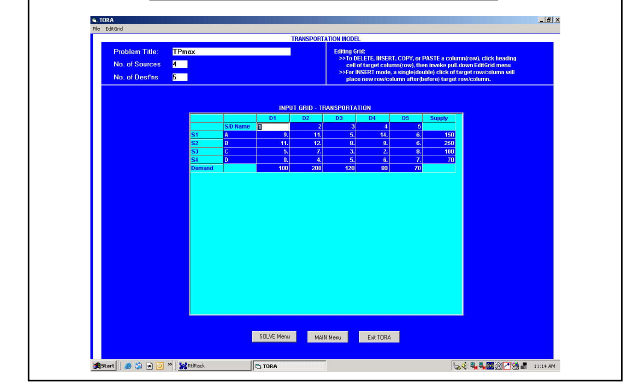| Particulars | Plant | |||
| A | B | C | D | |
| Production cost per unit (Rs.) | 18 | 17 | 15 | 12 |
| Capacity | 150 | 250 | 100 | 70 |
The company has five warehouses. The demands at these warehouses and the transportation costs per unit are given in the Table 2 below. The selling price per unit is ₹ 30.
| Warehouse | Transportation cost (Rs) — Unit-wise |
Demand | |||
| A | B | C | D | ||
| 1 | 6 | 9 | 5 | 3 | 100 |
| 2 | 8 | 10 | 7 | 7 | 200 |
| 3 | 2 | 6 | 3 | 8 | 120 |
| 4 | 11 | 6 | 2 | 9 | 80 |
| 5 | 3 | 4 | 8 | 10 | 70 |
- Formulate the problem to maximize profits.
- Find the total profit.
Solution:
- The objective is to maximize the profits. Formulation of transportation problem as profit matrix table is shown in Table 3. The profit values are arrived as follows.
Profit = Selling Price –Production cost –Transportation cost
| Destination | |||||
| A | B | C | D | Demand | |
| 1 | 6 | 4 | 10 | 15 | 100 |
| 2 | 4 | 3 | 8 | 11 | 200 |
| 3 | 10 | 7 | 12 | 10 | 120 |
| 4 | 1 | 7 | 13 | 9 | 80 |
| 5 | 9 | 9 | 7 | 8 | 70 |
| Supply | 150 | 250 | 100 | 70 | 570 |
Converting the profit matrix to an equivalent loss matrix by subtracting all the profit values in Table No. 3 from the highest value 13. Subtracting all the values from 13, the loss matrix obtained is shown in the Table 4.
Destination
| A | B | C | D | Demand | |
| 1 | 9 | 11 | 5 | 0 | 100 |
| 2 | 11 | 12 | 7 | 4 | 200 |
| 3 | 5 | 8 | 3 | 5 | 120 |
| 4 | 14 | 8 | 2 | 6 | 80 |
| 5 | 6 | 6 | 8 | 7 | 70 |
| Supply | 150 | 250 | 100 | 70 | 570 |
- To determine the initial solution using TORA
Input Screen:

Output Screen:

The first iteration itself is optimal, hence optimality is reached.
- To find the total cost:
The total maximization profit associated with the solution is
Total Profit = (6 × 10) + (4 × 20) + (10 × 120) + (3 × 180) + (9 × 70) + (10 × 20) + (13 × 80) + (15 × 70)
= 60 + 80 + 1200 + 540 + 630 + 200 + 1040 + 1050
= ` 4800.00
Total Views: 19
